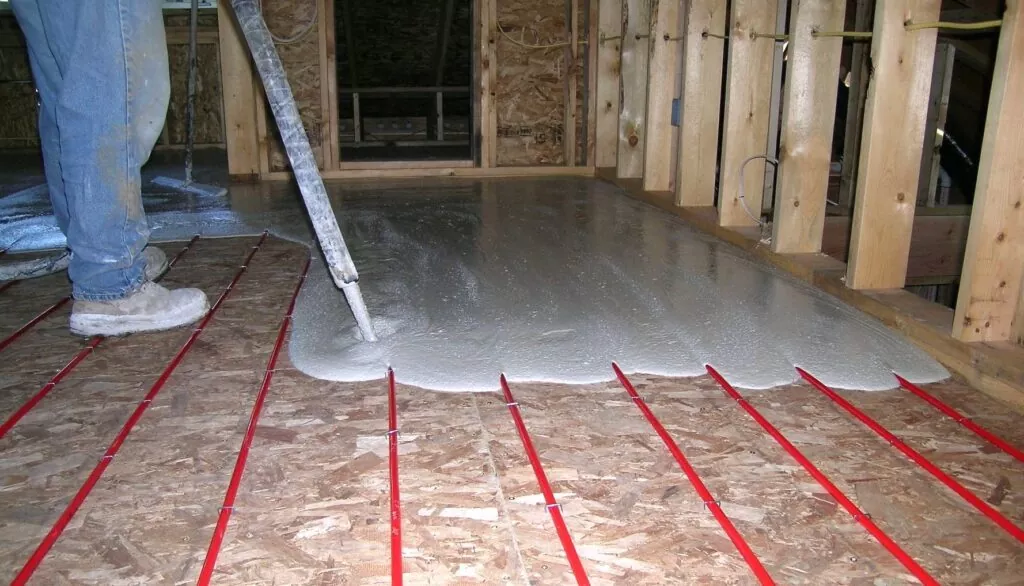
#Concrete radiant floor heating cost install
Underfloor heating is more expensive to install than a comparable radiator system - it typically costs 20% to 50% more.Of course there are also downsides of UFH to consider - particularly if you plan to retrofit underfloor heating. Safer for children, and better for indoor air quality.Removes need for space-stealing radiators - underfloor heating increases the available floor area of a house by 15%.Compatible with many types of flooring.Runs at a lower temperature than radiators, meaning UFH is more energy efficient.Underfloor heating holds many advantages over other types of heating system, including radiators. (Image credit: Getty) What are the advantages of underfloor heating? This means that running costs become an issue and the extra trouble and expense of a wet system may be well worthwhile.Įlectric underfloor heating is a good option for those installing a system in an existing room. Typically these areas need a lot of heat and are used for relatively long periods of the day (compared to a bathroom, for example). It is worth noting that one of the most common - and worst - uses for electric underfloor heating is in a conservatory. It is often a good idea to install electric underfloor heating in a small, single area like a bathroom or en suite, where it may be difficult to install wet underfloor heating. Luckily, wireless underfloor heating thermostats (some of which can be controlled with a phone app) make installation far easier. Where underfloor heating is added to an existing radiator system then a different control system will be needed. This means that the floor will heat up and cool down far more quickly than conventional underfloor heating. Low-profile systems tend to have smaller diameter pipes and run at a higher temperature. However, if you're looking to retrofit underfloor heating in a renovation project, it can be hugely disruptive and expensive as it often involves taking up floors that may otherwise be best left alone, or raising the floor level, which may have implications on the joinery (doors, skirting etc). In a new build, the extra cost of underfloor heating relative to the whole build cost is seldom a deal breaker. (Image credit: JK Heating) Can I install underfloor heating into my existing home? It's easy to control your underfloor heating and zone off certain areas as seen being installed by JK Floorheating (opens in new tab). There is no regular maintenance regime associated with underfloor heating, but if things do go wrong, it will typically be with the heating control systems rather than the system itself. The zone control will be placed somewhere where the homeowner can make adjustments, while the underfloor heating manifolds will be placed out of the way – under the stairs or in a cupboard – so as to be unobtrusive.

The underfloor heating manifolds and valves that the zone control operates.A digital zone control that determines the temperature of each room/area.The majority of underfloor heating system controls feature two main parts: What is the best way to control underfloor heating? Electric underfloor heating is believed to be around three times more expensive than wet systems as electricity is more expensive. It's worth noting too that underfloor heating systems have a lifespan of 50 years plus, while the average radiator will only last between 8-12 years before becoming inefficient.Ī wet underfloor heating system is estimated to be 25% cheaper to run than radiators when attached to a modern boiler and 40% cheaper when attached to a heat pump. The running costs are generally far lower for UFH than radiators. While underfloor heating has a higher initial expenditure than radiators, don't let this put you off. Is underfloor heating more expensive than radiators? This isn't necessarily more expensive than electric underfloor heating systems, and in fact, some of the more advanced electric systems will cost more. You might expect retrofitting underfloor heating in a renovation project to cost slightly more at around £40/m2 to £60/m2. These figures will vary depending on the size of the property, the amount of heating the building needs and whether it is a new build, renovation or conversion. Wet underfloor heating costs from around £20/m2 to £40/m2 installed, based on a new build or extension.

(Image credit: Getty) How much does underfloor heating cost? In most cases, underfloor heating pipes will be buried underneath and screed, which will need to fully dry out before your final floor finish can be laid.


 0 kommentar(er)
0 kommentar(er)
